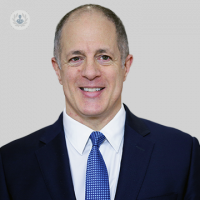Varicose veins and thread veins: what's the difference and how are they treated?
Escrito por:Varicose veins and thread veins are a common problem among UK adults - particularly among women, who more commonly experience the two. However, what's the difference? What are the symptoms, and is treatment always necessary? Expert vascular surgeon Mr Ian Franklin talks to Top Doctors about the difference between varicose veins and thread veins, and how they are commonly treated in his clinic.

What are varicose veins?
Varicose veins are the lumpy, squiggly, torturous veins which can be seen in people’s legs. They are frequently asymptomatic but many find them to be unsightly, and in some cases they are associated with discomfort, swelling, or itching.
Are varicose veins simply a cosmetic problem?
Varicose veins are not just a cosmetic problem. Unsightliness may be an important concern but varicose veins are progressive. If left untreated, they tend to get bigger, more unsightly, and more crucially, they can start to damage the skin. The skin can start to get quite itchy and thickened and if left untreated, in many cases this can cause quite bad skin damage. As a result, some people develop a leg ulcer later in life. 90% of the leg ulcer patients that we see have them as a result of varicose veins which have not been treated. Therefore, it is important to emphasise that varicose veins are not simply a ‘cosmetic problem’.
How are varicose veins treated?
The key to treating varicose veins is not to examine simply on the surface, but to conduct a detailed Doppler ultrasound scan to look at the veins inside the leg. This is important, as the lumpy, faulty vein on the outside occurs due to a valve somewhere inside the legs that has stopped working properly. This valve then allows blood to flow in the wrong direction, causing varicose veins to form on the surface as a result of the pressure blowout.
Once the clinical assessment of the varicose veins is done, a Doppler ultrasound scan is performed in order to work out what the internal problem is in the leg. Once the scan is done, there are a multitude of different treatments available for the patient. The selection of treatment is strongly influenced by the findings on the Doppler scan.
What is the difference between varicose veins and thread veins?
Thread veins are also known as spider veins, capillary veins. They are different to varicose veins in that they appear as purple or red-coloured blotches of squiggly veins on the skin surface which are very fine. Thread veins are very fine, but because there are often lots of them close together, they can be disfiguring, and can look like a large bruise that doesn't go away. Even though they are not particularly important from a health point of view, unlike varicose veins, they can be very unsightly and people can be very self-conscious of them.
How can thread veins be treated?
Thread veins can be very effectively treated but it is very important to make sure that there is no underlying vein anomaly before treatment is carried out. We often see patients who have gone through a great deal of time, trouble and expense in trying to get rid of their thread veins. When these patients are assessed more carefully, we often see that there is a problem inside the leg. In cases like this, the protocol is to assess the limb, and do a Doppler scan, which we conduct to be sure there is no internal problem. If results are clear, treatment proceeds, usually in the form of either microinjections or laser treatment to lessen the appearance of the thread veins.
The treatments for thread veins are very effective but, but they can sometimes take a bit longer than both the patient and the specialist wish. For thread veins to be completely treated, it may take more than one session spaced out over a period of time. This said, the medium to longer term results in the treatment of thread veins are excellent and highly successful.


